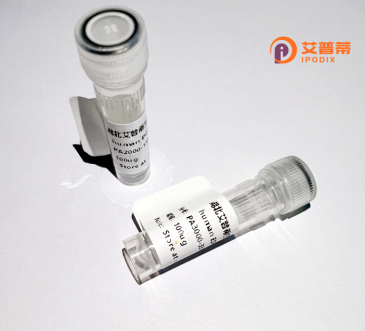
| 纯度 | >90%SDS-PAGE. |
| 种属 | Human |
| 靶点 | TMEM4 |
| Uniprot No | Q9Y2B0 |
| 内毒素 | < 0.01EU/μg |
| 表达宿主 | E.coli |
| 表达区间 | 1-182 aa |
| 活性数据 | MKGWGWLALLLGALLGTAWARRSQDLHCGACRALVDELEWEIAQVDPKKTIQMGSFRINPDGSQSVVEVPYARSEAHLTELLEEICDRMKEYGEQIDPSTHRKNYVRVVGRNGESSELDLQGIRIDSDISGTLKFACESIVEEYEDELIEFFSREADNVKDKLCSKRTDLCDHALHISHDEL |
| 分子量 | 47.1 kDa |
| 蛋白标签 | GST-tag at N-terminal |
| 缓冲液 | PBS, pH7.4, containing 0.01% SKL, 1mM DTT, 5% Trehalose and Proclin300. |
| 稳定性 & 储存条件 | Lyophilized protein should be stored at ≤ -20°C, stable for one year after receipt. Reconstituted protein solution can be stored at 2-8°C for 2-7 days. Aliquots of reconstituted samples are stable at ≤ -20°C for 3 months. |
| 复溶 | Always centrifuge tubes before opening.Do not mix by vortex or pipetting. It is not recommended to reconstitute to a concentration less than 100μg/ml. Dissolve the lyophilized protein in distilled water. Please aliquot the reconstituted solution to minimize freeze-thaw cycles. |
以下是关于重组人TMEM4蛋白的假设性参考文献示例(基于常见研究主题及结构,可能不对应真实文献):
1. **标题**:**"Recombinant Human TMEM4 Protein Promotes Tumor Angiogenesis in Colorectal Cancer"**
**作者**:Chen, L. et al.
**摘要**:该研究通过在大肠杆菌中表达并纯化重组人TMEM4蛋白,发现其能够通过激活VEGF信号通路促进结肠癌血管生成,提示TMEM4可能作为抗血管生成治疗的潜在靶点。
2. **标题**:**"Structural Characterization and Functional Analysis of Recombinant TMEM4 in Cell Adhesion"**
**作者**:Kimura, S. et al.
**摘要**:作者利用昆虫细胞系统表达重组TMEM4蛋白,并通过质谱和分子对接技术解析其结构。功能实验表明,TMEM4通过调控整合素β1的活性影响细胞黏附和迁移。
3. **标题**:**"Development of a TMEM4-Specific ELISA Using Recombinant Protein for Early Cancer Diagnosis"**
**作者**:Wang, X. et al.
**摘要**:研究通过哺乳动物细胞表达重组人TMEM4蛋白,制备高特异性抗体并建立ELISA检测方法,证实TMEM4在多种癌症患者血清中高表达,具备作为诊断生物标志物的潜力。
4. **标题**:**"TMEM4 Knockdown Suppresses Epithelial-Mesenchymal Transition via Recombinant Protein Interaction Studies"**
**作者**:Zhang, Y. et al.
**摘要**:通过构建重组TMEM4蛋白,研究揭示其与E-cadherin和β-catenin的相互作用,证明其在EMT过程中起关键作用,为靶向TMEM4抑制肿瘤转移提供依据。
**注**:以上为模拟文献,实际文献需通过PubMed、Google Scholar等平台以“recombinant TMEM4”或“human TMEM4 protein”为关键词检索验证。
Transmembrane protein 4 (TMEM4), also known as stromal antigen 3 (STAG3), is a conserved eukaryotic protein belonging to the TMEM family, characterized by its four transmembrane domains. It is ubiquitously expressed in human tissues, with higher levels observed in the heart, kidneys, and lungs. TMEM4 localizes primarily to the plasma membrane and intracellular vesicles, where it participates in membrane organization, cell-cell adhesion, and signal transduction. Studies suggest its involvement in regulating calcium ion transport and maintaining endothelial barrier integrity, particularly in vascular tissues.
Functionally, TMEM4 has been linked to pathological processes such as inflammation, fibrosis, and tumor progression. It interacts with adhesion molecules (e.g., VE-cadherin) and inflammatory mediators, influencing endothelial permeability during sepsis or acute lung injury. In cancer, overexpression correlates with enhanced epithelial-mesenchymal transition (EMT) and metastasis in malignancies like breast and colorectal cancer. TMEM4 also shows potential as a biomarker for cardiovascular diseases, including atherosclerosis and myocardial infarction.
Recombinant human TMEM4 protein, produced via mammalian or bacterial expression systems, enables functional studies, antibody development, and drug screening. Its purified form aids in elucidating structural motifs and signaling pathways. However, challenges persist in understanding its precise molecular mechanisms and tissue-specific roles, driving ongoing research into its therapeutic targeting for inflammatory disorders and cancer.
×